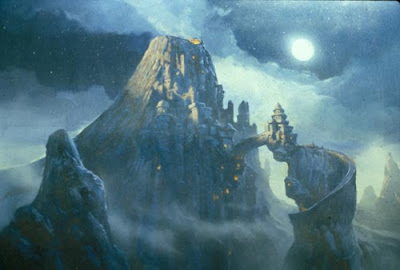
That’s me on the left and Tom on the right, working at Ralph Bakshi’s animation studio in Burbank, California, I believe in 1981.

Here’s the painting I have on my board in that photo, an establishing shot of “Fire Keep,” the castle of the good guys in the movie.
Tom and I had been assigned to each other as freshman roommates a few years earlier in 1976 at the University of California at Berkeley. He headed down to southern California to go to Art Center College of Design, and I followed there later.
At the point where we started at Bakshi Studios, we were each 21 years old. He had a lot more painting experience than I did, having painted hundreds of canvases since he was in grade school. I had drawn a lot, but hardly painted at all.
To answer Arnaud’s question yesterday, we walked in Bakshi’s door together and sold ourselves as a background painting team. But my skills sucked at the time. Tom helped me get the job, and I learned a lot by watching him paint. We had to match styles so that the backgrounds were interchangeable. So you might describe the Fire and Ice background style as by “Gurkinzetta.”
OK. Stories. One thing about Tom and me was that we both enjoyed pulling off practical jokes on the rest of the crew. Once, when the production coordinator came by to check on our progress, I grabbed a razor blade and start scraping the paint off the porcelain palette. I had made a fake thumb out of latex and I filled it with red paint.

Just when I turned around to tell her that the backgrounds were coming along fine, I pretended to slice off my thumb. The chunk of thumb bounced over on the floor next to her feet. She threw down the backgrounds she was holding and screamed. We took turns doing this stunt on just about everyone on the crew.
Tom and I were always thinking of how we could create an interesting diversion for the animators. They slaved away for countless hours in their dark cubicles, bored out of their minds, looking around for any distraction.
We found a roll of brown paper and unspooled a 100-foot-long piece. Tom grabbed the front end and I grabbed the back end. He started down the hallway, dragging the long piece of paper, and I followed along way behind. We snaked that piece of paper through all the hallways, past the open doors to the animation rooms.
The animators looked up from their work and waited and waited for the piece of paper to go by. It was a long time before I came along holding the tail end, waving and saying, “Long pan shot!”

All of our paintings were done in cel-vinyl acrylics, the same paints they used for painting the cells. They are remarkably small. Most are about 9x12 inches. This establishing shot of Nekron's glacier was about 11x14 inches.

Cel-Vinyl acrylic is very opaque and great to work with, but it it clogged the airbrushes, and it destroyed the Winsor and Newton Series 7 brushes that we used. Those brushes were beautiful and expensive, and I felt bad that they only lasted a few weeks. But we were each on a quota of 11 finished paintings a week.
Other posts in this series:
Part 1: Fire and Ice -- Rekindled
Part 2: Fire and Ice -- Frank Frazetta
Part 3: Fire and Ice -- Tom Kinkade
Part 4: Fire and Ice -- Ralph Bakshi
Part 5: Living Inside PaintingsWikipedia on Thomas Kinkade
Wikipedia on the original Fire and Ice.
Cartoon Color Cel Vinyl official site
Không có nhận xét nào:
Đăng nhận xét